Life
Durga's Arms

Kumortuli is India's potter street.
|
Overseas Bengalis throughout the Diaspora are feverishly preparing for Dasshera, arguably the world’s biggest festival in terms of people participation, in October. But Durga, the goddess at the heart of their festivities, began her journey across the seven seas several months earlier from Kumortuli, the nationally renowned potter’s street in North Kolkata, where the vast majority of India’s giant Dasshera statues are created.
During the past two decades, overseas Indian organizations from the United States and England to Canberra, Lisbon and Amsterdam, have sourced statues for their Dasshera celebrations from the artisans of Kumortuli. Studios and workshops line both sides of the street and surrounding alleys in Kumortuli, which literally means potters colony. The studios are dingy and dark and a visitor is likely to wonder how the artisans can create such beautiful and flawless idols year after year. Every studio is choc a bloc with 7 to 10 huge Durga idols and scores of smaller deities. As many idols are 5 to 7 feet high, the artisans work from atop a ladder. During the monsoons, the streets are often slippery as rainwater combines with the clay heaped around the studios. In the
bigger studios, helpers bring the clay inside for artists, but in smaller studios artist sit and work near the clay heap. An estimated 400 artisans and 2,000 other workers live and work in the narrow bylanes of Kumortuli, building an estimated 6,000 clay idols annually for the domestic market. Kumortuli exported 50 idols to 20 countries worldwide in 2007. While the overseas orders are small, each one is worth 10 times the price of a domestic order, so it’s impact is far more significant than the numbers might suggest. The vast majority of the overseas orders are from the United States, followed by the U.K. and Canada. In recent years, orders are trickling in from South East Asia, Hungary, Bulgaria, Russia, Austria and Poland.
The worship of Goddess Durga is a major event in the Bengali calendar. It is a special time not only for Hindu Bengalis in West Bengal, but for millions of other Hindus spread all over the world. Orders from overseas associations and clubs like the Cardiff Hindu Cultural Organization, Cambridge Bengali Association, Bengali Association of Southern California, etc., start six months in advance. Almost every Bengali association abroad celebrates the festival and many order the idols from Kumortuli every year. In India, the festival is traditionally celebrated over five days, but overseas the celebrations are typically squeezed into a weekend. Earlier, the statues were worshipped and then packed away for use the following year, even though tradition requires them to be immersed in the Ganges. Recently, however, some countries like the United Kingdom have begun allowing immersion of the idol in the Thames River, leading to a spurt in demand for Durga idols from Kumortuli.
Kumortuli churns out around $250,000 worth of idols for the overseas market every year, according to Mintu Pal, general secretary of the Kumortuli Mrith Shilpi Association. Shipping of the idols for export begins in the first week of July. While some studios courier the idols by air, most are shipped by sea, which can take two to three months.
The overseas orders, although constrained by shipping costs, are becoming ever more ambitious. While earlier the demand was for five feet tall idols, this year organizations in New Jersey and California have ordered seven feet tall idols, according to Pradyut Pal, who claims to be the first in Kumortuli to establish a website to cater to overseas clients with the aim of eliminating the middlemen, who eat into their profit margins. Amarnath Ghosh began shipping idols made out of pith overseas in 1989. His idols were flown to Sweden, Australia, Malaysia and Nigeria. The images were very light, weighing under 8 lbs. Today his sons carry on with tradition, sending the most idols, made of paper pulp, pith or fiber glass, every year to overseas destinations. In 2007 he shipped 20 idols and expects to top that number this year.
His son Kaushik Ghosh, who has also established a website, says their business is now exclusively export oriented: “The quality of our work separates us from everyone else. Every Kumortuli artisan sends 2-3 idols every year abroad, but we send the highest number of idols every year. We do not have time to take local orders and our entire year gets blocked with overseas order.”
Ghosh recalls that their first order two decades ago had come from a neighbor, who had migrated to the United States. Today, he knows he needs to improvise to retain his hold over the overseas market. He is helped in the task by his sister in law who is settled in the U.S., a website that promotes him globally and Skype, which he uses to interact with his overseas clients.
Kumortuli is now a well-known NRI brand, their first and often last stop in their quest for a Durga idol. The prices are steep by Indian standards. Pradyut Pal charges between $6,000 to $12,500 for an idol. He says that the competition is a lot tougher now as the market is expanding with new players: “There was a point of time when Kumortuli used to be chosen destination for NRIs who wanted to order a Durga idol. However that is not so anymore. There are so many people who come to learn at my workshop and then they go out and work on their own or with someone else. It does affect me, but it also encourages and challenges me to stay on top of my competition.”
For most artisans in Kumortuli, overseas orders are appealing as they come during their down time. Overseas orders are also financially more lucrative, although they demand a lot more perfection too. The business at Kumortuli is seasonal in nature, so artisans spend a considerable time of the year without work. Overseas orders start trickling in around December and January, soon after the current year’s celebrations are over, whereas local orders only begin pouring in toward the end of June and early July. Debabrata Pal has been making idols with his father for the past 50 years and in the last few years has sold idols abroad as well. This year he secured an order from the U.S. to build one idol at a cost of $6,000. Previously, he worked through an agency, but not any longer. He says that agents often play dirty when it comes to payment. He is also deliberating about floating his own website to publicize his creative services. For him the real competition lies in the possibility that soon people might start making the idols abroad. “There are many people who come here to learn in our workshops from abroad. I won’t be surprised if very soon people would start getting into this business from there. Now that will really affect our trade.” Prasanto Pal is a new entrant in the overseas market. He launched his website a year ago and this year secured three offers from Canada. He uses an agent, charging $1,000 to $1,700 per idol. After paying the agency, he makes a profit of $120 to $170. He is waiting for his website to catch on before dispensing with his agents. Prasanto Pal, however, prefers local orders, which are priced at almost a tenth of overseas orders (between $250 to $350 for the large clay idols) to overseas ones, which are made of pith or fiber glass, because he feels the profits don’t justify the added hassles of transporting the idols to their destinations. However, he admits that overseas contracts help them in gathering more local orders. “Local customers are always impressed if they know that we have been sending idols abroad. So it gains us prestige and credibility and attracts local customers. We prefer local orders more though as they provide us our bread and butter throughout the year. Overseas orders are just stop gap arrangements.”
The Internet is coming to Kumortuli big time. Many studios have started their own websites and are dealing with clients directly. Many in the present generation of artisans are educated and technology savvy and those who are not are either striving hard to catch up or taking the help of technologically aware family members. The Internet dispenses with the need for agents who skim the studio’s profits. The most direct threat to the artisans of Kumortuli comes from local competitors who are beginning to crop up, creating what is known as a parallel Kumortuli. Dev Ranjan Dey, of Dev Exports, who has two workshops in the outskirts of West Bengal, where artisans execute the designs made his team, says his product and prices are better than those of Kumortuli. “Kumortuli is not our competition,” he says. “The images from Kumortuli are very high priced. However, we are not here to break their monopoly, but to offer an alternative option to people who would want it.” Dev’s idols for overseas markets are priced at $2,600, including shipping and handling. His marketing strategy is modern and streamlined. He says, “Every time when we send an idol, we always put a surprise gift in the box, be it festival issues of magazines or festival CDs and cassettes. It always gives our clients a lot of happiness.” And it ensures goodwill and word of mouth publicity. Mintu Pal says: “There is no dearth of talent in West Bengal, but Kumortuli is part of Kolkata’s heritage. We have the best artisans from all over the state working here. No one can compete with that. No matter where people have their studios and who they work with, originally all artisans hail from Kumortuli. No one can take away this from us.” In any event, even as competitors grow, the client base is expanding too. The latest entrant is Qatar, a Muslim country that bans idol worship. However, when a Bengali association got in touch with Dey, they brainstormed to create a Durga image, which legally cannot be classified as an idol. They came up with a 3D effect on a terracotta tile, which can be carried in a suitcase as an artifact. And this year it is expected to fly to Qatar in September for the celebrations. |

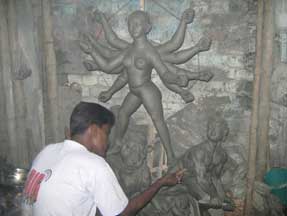
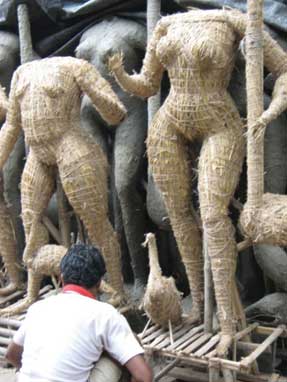
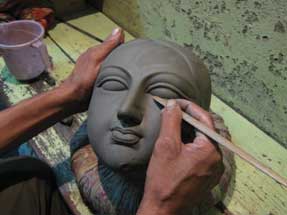
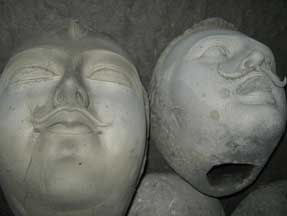
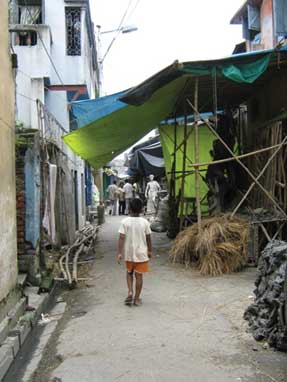
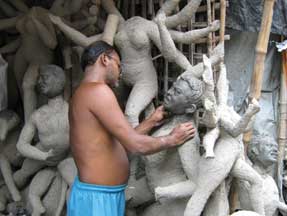
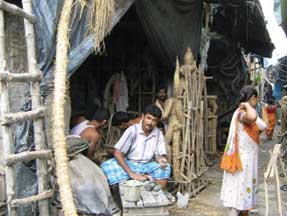
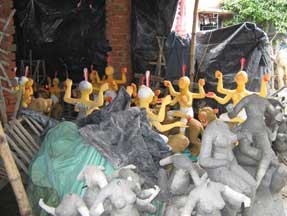
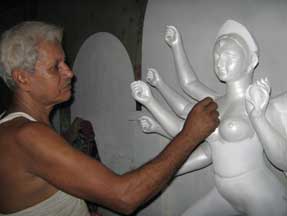
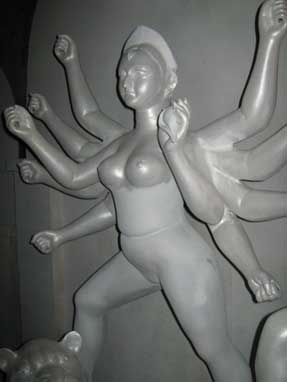
You must be logged in to post a comment Login